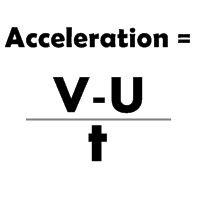The velocity of an object is its speed in a given direction. If an object changes direction it changes velocity, even if its speed stays the same. If the velocity of an object changes we say it accelerates. We can calculate acceleration using the equation: A= the acceleration in metres per second, m/s² , V= the final velocity, m/s U= the initial velocity, m/s , T = the time taken for the change in seconds, s
If the value calculated for acceleration is negative, the body is decelerating, slowing down. A deceleration is the same as a negative acceleration. 
Comments
No comments have yet been made